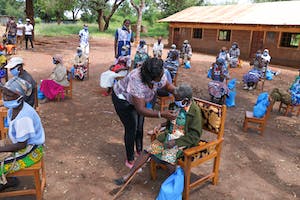Introduction

Rural settlements serve as a locus of human activities and an essential component of any country’s physical and social landscape. Numerous factors such as geography, climate, economic activities, and cultural traditions shape the patterns and types of rural habitat. In this article, we will delve into a comprehensive exploration of the four different types of settlements: dispersed settlements, nucleated settlements, linear settlements, and planned settlements. By understanding the distinctive features and characteristics of each type, we can gain valuable insights into the variations in settlement patterns across different regions.
Dispersed settlements
Dispersed settlements are characterized by scattered dwellings spread across a wide area. The physical separation between households often reflects agricultural practices that require ample agricultural land. These settlements are commonly found in regions with fertile soil, such as the vast agricultural plains of the American Midwest. Due to the considerable distances between households, social networks are often weaker in dispersed settlements, which can lead to a sense of isolation amongst residents.
Nucleated settlements
In contrast to dispersed settlements, nucleated settlements consist of closely clustered dwellings. These settlements usually arise in areas with hilly terrain or limited agricultural land. The compactness of nucleated settlements promotes the efficient use of land and facilitates communal activities and labor-sharing among residents. Villages found in the Swiss Alps exemplify this settlement type, where houses are tightly packed together for protection against the harsh natural environment.
Linear settlements
Linear settlements are characterized by a narrow and elongated shape, often situated along transportation routes or physical barriers such as rivers or coastlines. This settlement type is commonly observed near highways, railroads, or rivers, where proximity to transportation facilities enables easy access to nearby markets. The linear shape facilitates trade and commerce, as small businesses can efficiently serve passing travelers. Examples of linear settlements include the historic trading posts along the Silk Road or the picturesque coastal towns lining the Amalfi Coast in Italy.
Planned settlements
Planned settlements, as the name suggests, are carefully designed and purposefully constructed. Unlike other types of settlements that evolve naturally over time, planned settlements are developed with predetermined layouts and specific objectives. These settlements typically serve administrative, military, or industrial purposes, such as company towns built by coal mining corporations in the 19th century. The layout of planned settlements often includes standardized housing, amenities, and infrastructure, creating a cohesive and organized community.
Comparative analysis
While each type of rural settlement possesses unique characteristics, it is crucial to recognize that overlaps and combinations can exist. For instance, nucleated settlements may also incorporate planned components to ensure effective land utilization and infrastructure development. Similarly, linear settlements can overlap with nucleated settlements when clusters of houses form along transportation routes. This highlights the dynamic nature of settlements and the potential for multiple settlement types to coexist simultaneously.
Implications for land management
The understanding and study of rural habitats have profound implications for land management and development policies. Governments and planning agencies can utilize this knowledge to devise effective land-use strategies, infrastructure planning, and environmental conservation efforts. By identifying the dominant settlement type in a particular region, policymakers can tailor land use regulations, transportation networks, and economic development plans to suit specific needs and maximize the potential of rural areas.
Socio-economic impact
The distinct characteristics of rural settlements impact various socio-economic factors. Dispersed settlements often rely on agriculture as their primary economic activity, leading to economic interdependence among residents. Nucleated settlements, on the other hand, may foster stronger communal ties and social cohesion, enabling cooperative ventures and joint resource management. Linear settlements often benefit from economic opportunities facilitated by transportation routes, promoting trade, tourism, and service-based industries.
Cultural preservation and heritage
Rural settlements offer a glimpse into a community’s cultural heritage and traditions. The unique architectural styles, settlement layouts, and local customs embedded within settlements illustrate the historical and cultural significance of a region. Preservation efforts can aim to safeguard these distinct attributes and promote tourism, allowing visitors to experience the authenticity of rural life and immerse themselves in local cultural practices.
Challenges and opportunities for rural settlements
While rural settlements contribute to the rich diversity of human habitats, they also face numerous challenges. Rural depopulation, lack of access to healthcare and education, and limited economic opportunities.

Rural Development in South Africa since Independence
Since gaining independence in 1994, rural development has been an imperative focus for South Africa, a nation marked by its stark economic disparities and historical inequalities. This essay aims to provide a comprehensive analysis of the initiatives and challenges encountered in the country’s pursuit of rural development post-independence. Drawing on extensive research and scholarly literature, it will evaluate the impact of various policies, programs, and strategies on the socio-economic wellbeing of rural communities, while considering the complexities of this multifaceted endeavor.
Historical Context
To grasp the significance of rural development in South Africa, it is crucial to acknowledge the historical legacies of apartheid, which severely marginalized and disadvantaged rural communities. The past three decades have witnessed the government making determined efforts to redress these inequalities and create a more inclusive society through rural development initiatives.
Government Policies
Post-independence, the South African government swiftly implemented various policies to address rural development disparities. Notable policies include the Integrated Sustainable Rural Development Programme (ISRDP) and the National Rural Youth Service Corps (NARYSEC). Both aimed to ensure access to basic infrastructure, education, healthcare, and job opportunities for rural communities, while promoting sustainable development models.
Infrastructure Development
Infrastructure development has been a vital component of rural development in South Africa. Significant investments have been made in expanding transportation networks, enhancing access to clean water and sanitation, and electrification programs. The provision of infrastructure has played a critical role in improving the quality of life for rural communities by linking them to urban centers and improving their overall economic prospects.
Agricultural Development
Given the agrarian nature of many rural communities, agricultural development has been a key focus. The government has implemented various programs to support small-scale farmers, enhance agricultural productivity, and promote sustainable farming practices. Initiatives such as the Comprehensive Agricultural Support Programme (CASP) and the Land Redistribution and Agricultural Development (LRAD) program have aimed to address historical land injustices and support rural livelihoods.
Education and Skills Development
Education and skills development have been recognized as essential tools for poverty alleviation and rural upliftment. South Africa has prioritized investment in educational infrastructure and vocational training programs to empower rural youth with the necessary skills for employment and entrepreneurship. Such initiatives have aimed to bridge the urban-rural education divide and promote socio-economic inclusion.
Social Welfare and Community Empowerment
Developing social welfare programs and community empowerment schemes have been crucial in reducing rural poverty and inequality. The government has supported initiatives that provide social grants, healthcare services, and community-driven development projects. These efforts seek to enhance the capabilities and agency of rural communities, enabling them to actively participate in decision-making processes.
Challenges and Limitations
Despite the efforts made, rural development in South Africa faces numerous challenges. Persistent socio-economic inequalities, inadequate institutional capacity, and the legacy of apartheid continue to hamper progress. Insufficient funding, corruption, and ineffective implementation have also limited the impact of development initiatives. Furthermore, the COVID-19 pandemic has exposed vulnerabilities within rural communities, leading to setbacks in various development goals.
South Africa’s pursuit of rural development since independence has been a complex and multifaceted endeavor. While notable progress has been made in infrastructure development, agricultural support, education, and social welfare, existing challenges and limitations persist. Achieving sustainable rural development requires continued commitment from the government, improved governance, and equitable resource allocation. Only through comprehensive policies, community participation, and continuous evaluation can South Africa overcome the historical legacies and transform its rural areas into thriving and inclusive communities.

Comparison between Rural and Urban Development in Africa
Development in Africa is exploring various avenues to bridge the gap between rural and urban areas. This essay will analyze the differences and similarities in the patterns of development in rural and urban areas. It will delve into topics such as infrastructure, education, healthcare, economic opportunities, access to technology, and social services. By exploring these aspects, we can gain valuable insights into the challenges faced by both rural and urban areas, and identify strategies to ensure balanced development across Africa.
Infrastructure
A fundamental issue in Africa’s development lies in the stark disparity of infrastructure between rural and urban areas. Urban areas tend to have well-developed road networks, transportation systems, and access to electricity and clean water, whereas rural communities often face a lack of basic infrastructure. This disparity hampers economic growth and results in unequal development across regions.
Education
Another significant contrast between rural and urban areas in Africa lies in the provision of education. Urban areas usually have more educational institutions with better facilities, qualified teachers, and access to a wide range of resources. Conversely, rural areas suffer from limited access to quality education due to a shortage of schools, lack of resources, and difficulty retaining trained teachers. This disparity exacerbates the cycle of poverty in rural communities, hindering their overall development.
Healthcare
Healthcare services in Africa also exhibit major discrepancies between rural and urban areas. Urban centers generally have well-equipped hospitals with trained medical professionals, while rural areas struggle with limited access to healthcare facilities. This inequality in healthcare provision further impacts the welfare and development of rural populations, leading to higher mortality rates and reduced life expectancy.
Economic Opportunities
Urban areas in Africa often offer better economic opportunities compared to rural areas. They attract industrial and commercial investments, resulting in employment opportunities for the local population. In contrast, rural areas primarily depend on agriculture, which faces challenges such as limited access to markets, lack of infrastructure, and low productivity. Thus, rural communities are often left marginalized in terms of economic development and job opportunities.
Access to Technology
Access to technology is a vital determinant of development in the modern era. Urban areas in Africa typically enjoy better connectivity, information technology infrastructure, and access to the internet. This digital divide contributes to the socio-economic disparities between rural and urban regions, as it limits rural communities’ ability to participate in the global knowledge economy and impedes their overall development.
Social Services
Urban areas generally have more comprehensive social services, including social welfare programs, housing schemes, and recreational facilities. These amenities enhance the quality of life in urban areas by providing safety nets and promoting community cohesion. Conversely, rural communities often lack access to such social services, leading to lower living standards and a higher degree of social exclusion.
Conclusion on rural settlement
In conclusion, the comparison between rural and urban development in Africa reveals significant disparities across various dimensions. Unequal access to infrastructure, education, healthcare, economic opportunities, technology, and social services hinder balanced development and perpetuate the cycle of poverty in rural areas. Addressing these challenges requires comprehensive policies that focus on building infrastructure, promoting education, improving healthcare, enhancing economic opportunities, bridging the digital divide, and providing equitable social services. By adopting a holistic approach to development, Africa can strive towards inclusive growth, narrowing the gap between rural and urban areas, and improving the overall well-being of its people.

